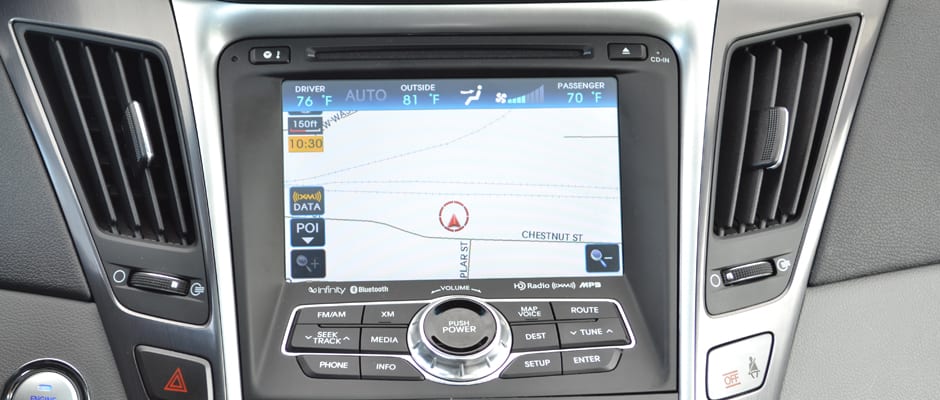Introduction
Even with its improvements, the Sonata Hybrid gets similar gas mileage to a slightly smaller, non-hybrid sedan, and doesn't come close to the Toyota Prius' 50+ mpg rating. We suspect that won't matter to hybrid Hyundai buyers, however. They'll recognize this car for what it is: a traditional, well-equipped, midsize five-seater that just happens to squeeze out a few more miles per gallon thanks to a hybrid drivetrain.
Tech & Entertainment
The Sonata Hybrid also offers Hyundai's Blue Link telematics service
Hyundai's navigation and infotainment system is simple, but effective. There's no smartphone connectivity, but there is an easy-to-read touchscreen with little lag time. We think the interface could be simplified — too many virtual and physical buttons have essentially the same function — but it's not particularly frustrating. One bigger drawback: Hyundai bundles its nav system on the Hybrid Limited. That means you'll have to pony up a few grand in other options.
In addition to pulling the Sonata over and entering a destination or point of interest manually while the car is stopped, Hyundai also allows drivers to sign up for BlueLink, an optional service that costs between $79 and $279 a year based on how many features are on deck. On our tester, which had the highest level subscription, it offered voice-operated point of interest search and destination entry in addition to crash response and a number of other features.
It's similar to GM's OnStar, except it tries to use advanced voice recognition whenever possible instead of deploying the customer service agents right off the bat.
On a good day, it takes less than a minute for you to say the name or address of a destination and have the Sonata's nav system take over with directions. Another cool feature is that it offers restaurant reviews, though they're somewhat limited. Other cars feature a Yelp app on the dash. In this Hyundai, you might want to pull over and ask a local where to dine.
Design
If you haven't seen a Hyundai in the past five years, the Sonata Hybrid's interior will be a pleasant surprise.
Hyundai's new design language started with the Sonata and expanded across their lineup. The Hybrid adds chrome trim and plenty of badges touting their "Blue" hybrid drive system. The Hybrid is visually different from other Sonatas thanks to its larger air intake at the front. We asked around for opinions and it's definitely a "love it or hate it" design. For 2013, Hyundai also gave the Sonata Hybrid two new wheel choices.
{{photo_gallery "Driver Side Door Open Photo", "Steering Wheel & Dash Photo", "Gauge Cluster Photo", "Center Stack Photo", "Shifter Photo", "Cup Holders & Storage Photos", "DS Inside Door Photo", "Passenger Side Door Open Photo", "In-floor Storage Compartments Photo", "Glove Compartment Photo", "Fit & Finish Photo", "Side Controls Photo", "Back Seat Door Open Photo", "Back Seat with People Photo", "Leg Room Shot at Rear Photo", "Back Seat Folded Down Photo", "Third Row Photo", "Third Row Down Photo", "Trunk Open Empty Photo", "Trunk Open Full Photo", "Spare Tire Compartment Photo", "Interior Other Photos"}}
Inside, there are more references to hybrids, batteries and electric power than the minutes of a California Air Resources Board monthly meeting. While other cars use the central display in the gauge cluster to display turn-by-turn directions or to show what song is playing, the Hyundai's is little more than a glorified trip computer. It does plas a few short bars of a song that's reminiscent of Mariah Carey's "Hero" when the car is shut off.
Another benefit of the 2013 refresh: A battery that's slightly smaller, which increases cargo volume by 1.4 cubic feet.
{{photo_gallery "Driver Side Exterior Photo", "Passenger Side Exterior Photo", "Front Exterior Photo", "Back Exterior Photo", "Front DS Angled Exterior Photo", "Front PS Angled Exterior Photo", "Back DS Angled Exterior Photo", "Back PS Angled Exterior Photo", "Grills & Detail Exterior Photos", "Grills & Detail Exterior 2 Photo", "Under the Hood Photo", "Trunk Open Exterior Photo", "Gas Tank or Charging Port Photo", "Wheels & Wheel Space Photo", "Sunroof Photo", "Convertible Top Down Photo", "Exterior Other Photos"}}
Driving Experience
First off, fuel economy. The 2012 model we drove got around 33 mpg in a mix of city and highway driving. But the updated 2013 model managed around 35. While we didn't do hundreds EPA-approved test loops, that improvement is still in line with the official numbers: an increase in combined mpg from 36 to 38.
A Hyundai spokesperson said that none of the improvements to the 2013 were hardware-based, which means Hyundai just improved the already-existing hybrid setup. There's still a lifetime warranty on the battery, so Hyundai's engineers seem to be standing behind whatever magic they've worked out.
Overall, the Sonata Hybrid benefits from the fact it's based on one of the better mainstream front-wheel drive sedans on the market today. Like its conventional counterpart, the Hybrid has a great suspension that transmits just enough road feel without being too stiff for everyday driving. Its steering is a bit heavy at low speeds—meaning your arms will get a workout—and a bit vague at higher ones.
Unlike many hybrids, the Sonata has a conventional automatic instead of a continuously variable transmission (CVT). It's programmed more for fuel efficiency than for driving excitement.
On the 2012 model we drove, our major complaint was the nonlinearity of the hybrid drivetrain. The on-demand power of an electric motor combined with the lackluster acceleration from a smallish four cylinder gas engine made taking off from a full stop about as smooth and subtle as slipping on a banana peel.
That's been tweaked for 2013, and the handoffs between gas and electric power sources have also been smoothed out. In fact, only the slight distraction of a green "EV mode" lamp on the dashboard gave us a clue of when our 2013 tester was running on battery power. If you're trying to decided between a leftover 2012 and a brand new 2013, we recommend getting the newer car.
Conclusion
The Hyundai Sonata Hybrid seems to be a pretty good compromise: It's a traditional sedan with ample interior space, an eye-catching design, plenty of options, and a hybrid drivetrain.
Of course, a compromise inherently means sacrifices. You won't get the fuel economy of a Prius, nor will you get the low price of a base Sonata. But thanks to some improvements for the 2013 model, you'll get combined mileage in the high-mid-30s, plenty of room for people and cargo, and one of the smoother hybrid powertrains we've tested.
Trim Levels
For 2013, the Sonata Hybrid comes in three trim levels. The basic Hybrid starts at $26,650 plus $795 freight charge. The Limited starts at $30,550 and comes with navigation, an upgraded sound system, a power driver seat, heated rear seats, upgraded wheels. The Limited with Panoramic Sunroof gets — wait for it — a panoramic sunroof. It costs $31,550.
Powertrain
The Sonata Hybrid is only available as a front-wheel drive sedan with an automatic transmission. If you live in the snow belt and feel like that's a deal breaker, remember that all-wheel drive can help you start moving, but it won't help you stop any faster. It's always worth it to invest in a set of winter tires.
For 2013, the Sonata Hybrid's electric motor, starter generator, and battery output have all been improved. The battery's output has increased from 34 kW to 47 kW, but its weight has decreased by 5.2 percent.
Safety
The 2012 Sonata Hybrid got a five star overall rating from NHTSA, the highest the agency offers. It got five stars in each individual component except for frontal crash, where it got four stars.
IIHS has not tested a Sonata Hybrid, but a conventional Sonata GLS got a Top Safety Pick.
Fuel Economy
Hyundai calls their hybrid system Blue Drive, because blue was apparently the color most associated with environmental friendliness when product planners were dreaming up the battery-boosted Sonata's marketing strategy way back in 2010. It consists of lightweight lithium-polymer batteries, an Atkinson cycle four cylinder engine and an electric motor that work together in relative harmony.
The manufacturer claims the car can operate in EV only mode at speeds up to 62 mph, though the gas engine will kick in unless you're just coasting.
For 2012, the EPA rated the Sonata Hybrid at 34 city, 39 highway and 36 combined. For 2013, that's up to 36 hybrid, 40 highway and 38 combined.
Meet the tester
Keith was the Editor in Chief of Reviewed's appliance and automotive sites. His work has appeared in publications such as Wired, Car & Driver, and CityLab.
Checking our work.
Our team is here to help you buy the best stuff and love what you own. Our writers, editors, and experts obsess over the products we cover to make sure you're confident and satisfied. Have a different opinion about something we recommend? Email us and we'll compare notes.
Shoot us an email

